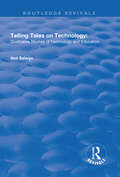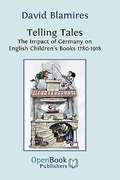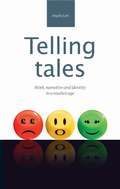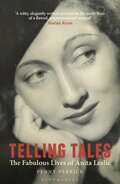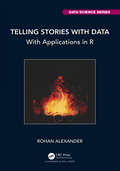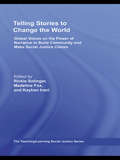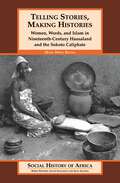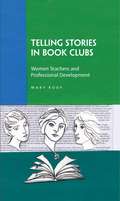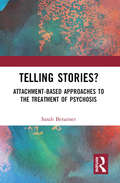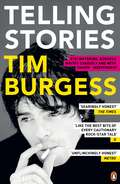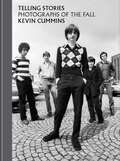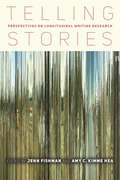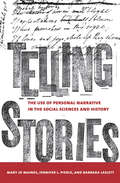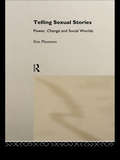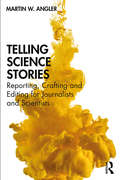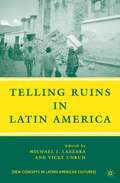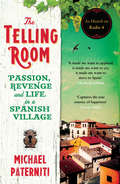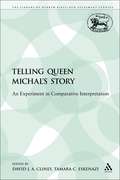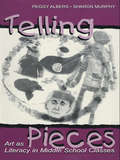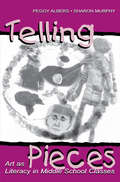- Table View
- List View
Telling Tales on Technology: Qualitative Studies of Technology and Education
by Neil SelwynThis title was first published in 2002.The educational potential of information and communications technology (ICT) has been speculated upon endlessly - from the early days of the micro-computer to the present excitement surrounding virtual education and e-learning . Now, with current multi-billion dollar initiatives such as the UK National Grid for Learning and US Technology Literacy Challenge, ICT is an unavoidable element of education. Yet despite a plethora of promises and policies, new technologies have failed to be wholly integrated into education. Telling Tales on Technology critically examines the role of ICT in education and explores how, given its assumed importance, new technology remains a peripheral part of much of what goes on in education. Based on in-depth qualitative studies, the book takes a comprehensive yet questioning look over the past two decades of educational technology policy and practice and positions it within the wider social, cultural, political and economic notion of the information age . Drawing on interviews with students, teachers, politicians and business people as well as comprehensive documentary analysis, this is an essential text for anyone thinking seriously about the use of ICT in education.
Telling Tales: The Impact of Germany on English Children’s Books 1780-1918 (PDF)
by David BlamiresGermany has had a profound influence on English stories for children. The Brothers Grimm, The Swiss Family Robinson and Johanna Spyri's Heidi quickly became classics but, as David Blamires clearly articulates in this volume, many other works have been fundamental in the development of English children's stories during the 19th century and beyond. Telling Tales is the first comprehensive study of the impact of Germany on English children's books, covering the period from 1780 to the First World War. Beginning with The Adventures of Baron Munchausen, moving through the classics and including many other collections of fairytales and legends (Musäus, Wilhelm Hauff, Bechstein, Brentano) Telling Tales covers a wealth of translated and adapted material in a large variety of forms, and pays detailed attention to the problems of translation and adaptation of texts for children. In addition, Telling Tales considers educational works (Campe and Salzmann), moral and religious tales (Carové, Schmid and Barth), historical tales, adventure stories and picture books (including Wilhelm Busch's Max and Moritz) together with an analysis of what British children learnt through textbooks about Germany as a country and its variegated history, particularly in times of war.
Telling tales: Work, narrative and identity in a market age
by Angela LaitBroad ranging, interdisciplinary, this book seeks to understand the corporate conceptions of identity and work, and how they are reflected in our wider culture - through novels, cookery writing, autobiography and the many constructions of narrative.
Telling Tales: The Fabulous Lives Of Anita Leslie
by Penny PerrickAnita Leslie (1914-85), best known for popular biographies of her relatives including Jennie Churchill, Winston's mother, was also an unlikely war heroine. In 1940, Anita volunteered as an ambulance driver. By the end of the war, she was the only woman to have been awarded both the Africa Star and the Croix de Guerre, alongside the other medals for her service across all four fronts of WWII, as recounted in her remarkable memoir Train to Nowhere. In this revealing biography, Penny Perrick brings Anita to life: her complicated early years, her love for her children, her passion for Ireland, her career as a writer, and the ongoing family drama about Castle Leslie. Telling Tales is a scintillating and poignant account of this flamboyant woman.
Telling Stories with Data: With Applications in R (Chapman & Hall/CRC Data Science Series)
by Rohan AlexanderThe book equips students with the end-to-end skills needed to do data science. That means gathering, cleaning, preparing, and sharing data, then using statistical models to analyse data, writing about the results of those models, drawing conclusions from them, and finally, using the cloud to put a model into production, all done in a reproducible way. At the moment, there are a lot of books that teach data science, but most of them assume that you already have the data. This book fills that gap by detailing how to go about gathering datasets, cleaning and preparing them, before analysing them. There are also a lot of books that teach statistical modelling, but few of them teach how to communicate the results of the models and how they help us learn about the world. Very few data science textbooks cover ethics, and most of those that do, have a token ethics chapter. Finally, reproducibility is not often emphasised in data science books. This book is based around a straight-forward workflow conducted in an ethical and reproducible way: gather data, prepare data, analyse data, and communicate those findings. This book will achieve the goals by working through extensive case studies in terms of gathering and preparing data, and integrating ethics throughout. It is specifically designed around teaching how to write about the data and models, so aspects such as writing are explicitly covered. And finally, the use of GitHub and the open-source statistical language R are built in throughout the book. Key Features: Extensive code examples. Ethics integrated throughout. Reproducibility integrated throughout. Focus on data gathering, messy data, and cleaning data. Extensive formative assessment throughout.
Telling Stories with Data: With Applications in R (Chapman & Hall/CRC Data Science Series)
by Rohan AlexanderThe book equips students with the end-to-end skills needed to do data science. That means gathering, cleaning, preparing, and sharing data, then using statistical models to analyse data, writing about the results of those models, drawing conclusions from them, and finally, using the cloud to put a model into production, all done in a reproducible way. At the moment, there are a lot of books that teach data science, but most of them assume that you already have the data. This book fills that gap by detailing how to go about gathering datasets, cleaning and preparing them, before analysing them. There are also a lot of books that teach statistical modelling, but few of them teach how to communicate the results of the models and how they help us learn about the world. Very few data science textbooks cover ethics, and most of those that do, have a token ethics chapter. Finally, reproducibility is not often emphasised in data science books. This book is based around a straight-forward workflow conducted in an ethical and reproducible way: gather data, prepare data, analyse data, and communicate those findings. This book will achieve the goals by working through extensive case studies in terms of gathering and preparing data, and integrating ethics throughout. It is specifically designed around teaching how to write about the data and models, so aspects such as writing are explicitly covered. And finally, the use of GitHub and the open-source statistical language R are built in throughout the book. Key Features: Extensive code examples. Ethics integrated throughout. Reproducibility integrated throughout. Focus on data gathering, messy data, and cleaning data. Extensive formative assessment throughout.
Telling Stories to Change the World: Global Voices on the Power of Narrative to Build Community and Make Social Justice Claims (Teaching/Learning Social Justice)
by Rickie Solinger Madeline Fox Kayhan IraniTelling Stories to Change the World is a powerful collection of essays about community-based and interest-based projects where storytelling is used as a strategy for speaking out for justice. Contributors from locations across the globe—including Uganda, Darfur, China, Afghanistan, South Africa, New Orleans, and Chicago—describe grassroots projects in which communities use narrative as a way of exploring what a more just society might look like and what civic engagement means. These compelling accounts of resistance, hope, and vision showcase the power of the storytelling form to generate critique and collective action. Together, these projects demonstrate the contemporary power of stories to stimulate engagement, active citizenship, the pride of identity, and the humility of human connectedness.
Telling Stories to Change the World: Global Voices on the Power of Narrative to Build Community and Make Social Justice Claims (Teaching/Learning Social Justice)
by Rickie Solinger Madeline Fox Kayhan IraniTelling Stories to Change the World is a powerful collection of essays about community-based and interest-based projects where storytelling is used as a strategy for speaking out for justice. Contributors from locations across the globe—including Uganda, Darfur, China, Afghanistan, South Africa, New Orleans, and Chicago—describe grassroots projects in which communities use narrative as a way of exploring what a more just society might look like and what civic engagement means. These compelling accounts of resistance, hope, and vision showcase the power of the storytelling form to generate critique and collective action. Together, these projects demonstrate the contemporary power of stories to stimulate engagement, active citizenship, the pride of identity, and the humility of human connectedness.
Telling Stories, Making Histories: Women, Words, and Islam in Nineteenth-Century Hausaland and the Sokoto Caliphate (Social History of Africa)
by Mary Wren BivinsThrough reconstruction of oral testimony, folk stories and poetry, the true history of Hausa women and their reception of Islam's vision of Muslim in Western Africa have been uncovered. Mary Wren Bivins is the first author to locate and examine the oral texts of the 19th century Hausa women and challenge the written documentation of the Sokoto Caliphate. The personal narratives and folk stories reveal the importance of illiterate, non-elite women to the history of jihad and the assimilation of normative Islam in rural Hausaland. The captivating lives of the Hausa are captured, shedding light on their ordinary existence as wives, mothers, and providers for their family on the eve of European colonial conquest.
Telling Stories in Book Clubs: Women Teachers and Professional Development
by Mary KooyThis book examines questions in the intersections of narrative, teaching, communities of learning, knowledge, women teachers and teacher development. Stories constitute the heart of this book and the glue that holds the pieces together. This book explores the ways women educators understand and make sense of their lives and develop their personal practical knowledge of teaching through narrative texts and experiences in informal learning groups.
Telling Stories?: Attachment-Based Approaches to the Treatment of Psychosis
by Sarah BenamerTelling Stories? explores the contemporary state of affairs in the understanding and treatment of psychosis. An inclusive approach to mental distress requires that in order to truly understand psychosis we must begin by listening to those who know this from the inside out; the voices and narrative of those who have been condemned as "unanalysable" and mad. Far from being fantastical, the complex stories that are being articulated communicate painful truths and the myriad ways in which the human psyche survives overwhelming trauma. This book is the culmination of an integrated and creative alliance between those on the cutting edge, experientially, in research, diagnosis, and treatment; this multidisciplinary dialogue proposes a new relational and attachment orientated paradigm for the 21st century. In contrast to the containment model that is currently favoured, this advocates listening and talking therapies, and the healing power of a loving relationship, offering those with psychosis the possibility of more nourishing engagement with the world.
Telling Stories?: Attachment-Based Approaches to the Treatment of Psychosis
by Sarah BenamerTelling Stories? explores the contemporary state of affairs in the understanding and treatment of psychosis. An inclusive approach to mental distress requires that in order to truly understand psychosis we must begin by listening to those who know this from the inside out; the voices and narrative of those who have been condemned as "unanalysable" and mad. Far from being fantastical, the complex stories that are being articulated communicate painful truths and the myriad ways in which the human psyche survives overwhelming trauma. This book is the culmination of an integrated and creative alliance between those on the cutting edge, experientially, in research, diagnosis, and treatment; this multidisciplinary dialogue proposes a new relational and attachment orientated paradigm for the 21st century. In contrast to the containment model that is currently favoured, this advocates listening and talking therapies, and the healing power of a loving relationship, offering those with psychosis the possibility of more nourishing engagement with the world.
Telling Stories
by Tim BurgessTelling Stories by Tim Burgess of The Charlatans is one of the decade's most revealing rock books'Clear, honest. An unusually frank and well-written rock memoir' The TimesThe Charlatans. Madchester. Britpop. Taking on the world. Here are the highs, the lows, the joys, the agonies, and the stories of what it's like to be in a rock band, as told by front man and survivor, Tim Burgess. 'Like the best bits of every cautionary rock star tale . . . there is armed robbery and smuggling. There's serious fraud. There are near and actual death experiences, divorce, industrial cocaine consumption and magnificent cameos from Madonna, Alan McGee, Ronnie Wood, Joe Strummer, LA drug dealer Harry The Dog, and Joaquin Phoenix. A minor classic' QFor readers who enjoyed Life by Keith Richards and Bit of a Blur by Alex James, Telling Stories is one of the finest music books of recent times. It's a story of achievement and survival, from London to LA. 'A vivid read' Independent on Sunday'The Charlatans' frontman recalls the heyday of Britpop and Madchester with endearing exuberance. He's unflinchingly honest about the bad times but also peppers his story with anecdotal nuggets about the pitfalls of rock 'n' roll excess' Metro'Burgess keeps a level head, a sharp eye and a nice turn of phrase' Independent'Written with the stylish flow of a novel - light and dark, hilarious and melancholic' Emma Forrest'For a man whose behaviour borders on the suicidal, Timothy Burgess, the people's friend, is what you call a life enthusiast. He is also mad. It's a much-abused word, mad . . . but he really is proper coo-ee clouds pan-dimensional mad mad' Syliva Patteerson, SkyTim Burgess was born in Salford but grew up in a village near Northwich, Cheshire. Leaving school at 16 to work at ICI, his real love was music and soon afterwards he was invited to join new band The Charlatans. For twelve years Burgess lived in Los Angeles but he has recently returned to the UK.
Telling Stories: Photographs of The Fall
by Kevin Cummins***'No one has captured the look of alternative UK music over the past half a century more tellingly than Kevin Cummins.' - Simon Armitage'Kevin Cummins is a true master in being able to capture the essence of music, the soul of the band. Whatever he does however he does it is a mystery to me but it's pure genius.' - Rankin'Kevin has the uncanny ability of capturing the inner mood of musicians. Be it the dynamics within a pensive Joy Division, or the sense surrounding the fledgeling Fall that something special was around the corner for us all. Kevin's book is nothing less than a remarkable document of a bewildering and defiant anti-fashion movement born in Prestwich, north Manchester in the grimy mid-70s.' - Marc Riley'Capturing forty years of the band's career via his archive, the legendary photographer (whose recent book, Juvenes, documented the story of Joy Division) gives his take on the phenomenon of The Fall and the late, great Mark E. Smith.' - Vive le Rock Contains never-before-seen images.Foreword by Simon Armitage, Poet Laureate. From chaotic early gigs to their final years, NME photographer Kevin Cummins provides a definitive, unique perspective on cult favourites The Fall. In this stunning visual history spanning four decades, discover how and why they emerged as one of the most innovative, boundary-breaking bands in modern music.With a foreword by Poet Laureate and Fall fan Simon Armitage and an interview with Eleni Poulou, as well as never-before-seen images from Cummins' archive, this is the ultimate visual companion to The Fall.
Telling Stories: Perspectives on Longitudinal Writing Research
by Jenn Fishman Amy Kimme HeaIn Telling Stories, more than a dozen longitudinal writing researchers look beyond conventional project findings to story their work and, in doing so, offer otherwise unavailable glimpses into the logics and logistics of long-range studies of writing. The result is a volume that centers interrelations among people, places, and politics across two decades of praxis and an array of educational sites: two-year colleges, a senior military college, an adult literacy center, a small liberal arts college, and both public and private four-year universities. Contributors share direct knowledge of longitudinal writing research, citing project data (e.g., interview transcripts, research notes, and journals), descriptions drawn from memory, and extended personal reflections. The resulting stories, tempered by the research and scholarship of others, convey a sense of longitudinal research as a lived activity as well as a prominent and consequential approach to inquiry. Yet Telling Stories is not a how-to guide, nor is it written for longitudinal researchers alone. Instead, this volume addresses issues about writing research that are germane to all who conduct or count on it. Such topics include building and sustaining good interpersonal research relations, ethically negotiating the institutional power dynamics that undergird writing research, effectively using knowledge from longitudinal studies to advocate for writers and writing educators, and improving both conceptual and concrete resources for long-range research in writing studies.
Telling Stories: The Use of Personal Narratives in the Social Sciences and History
by Mary Jo Maynes Jennifer L. Pierce Barbara LaslettIn Telling Stories, Mary Jo Maynes, Jennifer L. Pierce, and Barbara Laslett argue that personal narratives—autobiographies, oral histories, life history interviews, and memoirs—are an important research tool for understanding the relationship between people and their societies. Gathering examples from throughout the world and from premodern as well as contemporary cultures, they draw from labor history and class analysis, feminist sociology, race relations, and anthropology to demonstrate the value of personal narratives for scholars and students alike. Telling Stories explores why and how personal narratives should be used as evidence, and the methods and pitfalls of their use. The authors stress the importance of recognizing that stories that people tell about their lives are never simply individual. Rather, they are told in historically specific times and settings and call on rules, models, and social experiences that govern how story elements link together in the process of self-narration. Stories show how individuals' motivations, emotions, and imaginations have been shaped by their cumulative life experiences. In turn, Telling Stories demonstrates how the knowledge produced by personal narrative analysis is not simply contained in the stories told; the understanding that takes place between narrator and analyst and between analyst and audience enriches the results immeasurably.
Telling Sexual Stories: Power, Change and Social Worlds
by Ken PlummerFirst published in 2004. Routledge is an imprint of Taylor & Francis, an informa company.
Telling Sexual Stories: Power, Change and Social Worlds
by Ken PlummerFirst published in 2004. Routledge is an imprint of Taylor & Francis, an informa company.
Telling Science Stories: Reporting, Crafting and Editing for Journalists and Scientists
by Martin W. AnglerA practical manual for anyone who wants to turn scientific facts into gripping science stories, this book provides an overview of story elements and structure, guidance on where to locate them in scientific papers and a step-by-step guide to applying storytelling techniques to writing about science. In this book, Martin W. Angler outlines basic storytelling elements to show how and where fledgling science storytellers can find them in scientific output. Journalistic techniques like selection through news values and narrative interviews are covered in dedicated chapters. A variety of writing techniques and approaches are presented as a way of framing science stories in ways that are informative and compelling in different media – from short films to news articles. Practical examples, selected interviews and case studies complement each chapter, with exercises and experimentation suggestions included for deeper understanding. Review questions at the end of each chapter cement the newly gained knowledge to make sure readers absorb it, with links to articles and online tools inviting further reading. A valuable resource for students of journalism and science communication as well as professional journalists, scientists and scientists-in-training who want to engage with the public or simply improve their journal papers. This book is a one-stop shop on science storytelling with a clear focus on providing practical techniques and advice on how to thrive as science writers and communicate science in all of its complexity.
Telling Science Stories: Reporting, Crafting and Editing for Journalists and Scientists
by Martin W. AnglerA practical manual for anyone who wants to turn scientific facts into gripping science stories, this book provides an overview of story elements and structure, guidance on where to locate them in scientific papers and a step-by-step guide to applying storytelling techniques to writing about science. In this book, Martin W. Angler outlines basic storytelling elements to show how and where fledgling science storytellers can find them in scientific output. Journalistic techniques like selection through news values and narrative interviews are covered in dedicated chapters. A variety of writing techniques and approaches are presented as a way of framing science stories in ways that are informative and compelling in different media – from short films to news articles. Practical examples, selected interviews and case studies complement each chapter, with exercises and experimentation suggestions included for deeper understanding. Review questions at the end of each chapter cement the newly gained knowledge to make sure readers absorb it, with links to articles and online tools inviting further reading. A valuable resource for students of journalism and science communication as well as professional journalists, scientists and scientists-in-training who want to engage with the public or simply improve their journal papers. This book is a one-stop shop on science storytelling with a clear focus on providing practical techniques and advice on how to thrive as science writers and communicate science in all of its complexity.
Telling Ruins in Latin America (New Directions in Latino American Cultures)
by M. Lazzara V. UnruhThis book highlights the ruin's prolific resurgence in Latin American cultural life at the turn of the millennium and sharply reveals a stirring creative drive by artists and intellectuals toward ethical reflection and change in the midst of ruinous devastation.
The Telling Room: A Tale Of Love, Betrayal, Revenge, And The World's Greatest Piece Of Cheese
by Michael PaternitiIn the medieval Castilian village of Guzmán (population: 80), villagers have gathered for centuries in the 'telling room' to share stories and drink the local wine. It was here, in the summer of 2000, that Michael Paterniti found himself listening to a compelling tale about a cheese made from an ancient family recipe that was reputed to be among the finest in the world. Until, Ambrosio said, things had gone horribly wrong. Hooked on the story, Paterniti relocated his young family to the tiny hilltop village to find out more. But like many Spanish villages, Guzmán was rife with gossip and old feuds, secret alliances and plotted vengeance and before long Paterniti was sucked into the heart of an unfolding mystery. When he learned that the cheesemaker had apparently plotted to murder his closest friend, the village began to spill its long-held secrets, and Paterniti found himself implicated in ways he never expected ...
Telling Queen Michal's Story: An Experiment in Comparative Interpretation (The Library of Hebrew Bible/Old Testament Studies)
by David J. Clines Tamara C. EskenaziThis book, an anthology of previously published writing about Michal together with some new and original essays, is something of an experiment. Its purpose is to provide reders with raw materials for developing their own reading of the Michal story. It does not offer a unified portrait of this biblical character, but rather invites readers to form their own assessment interactively with these readings of the Michal story. At the same time, this book presents some systematic guidance for coping with these divergent interpretations of the complex and tantalizing figure of Michal.
Telling Pieces: Art As Literacy in Middle School Classes
by Peggy Albers Sharon MurphyTelling Pieces is an exploration of how pre-adolescent middle-school children develop a knowledge and understanding of the conventions of art (art as literacy) and how they use this knowledge to create representations of their lives in a small midwestern U.S. town. Beginning with an overview of social semiotics and emergent literacy theorizing, the authors set the stage for their study of sixth graders involved in art. A galleria of children's artworks is presented, allowing readers/viewers to consider these texts independent of the authors' interpretations of them. Then, set against the galleria is the story of the community and school contexts in which the artworks are produced--contexts in which racism, homophobia, and the repression of creativity are often the norm. The interpretation the authors bring to bear on the artworks reveals stories that the artworks may or may not tell on their own. But the tales of artistic literacy achievement are counterbalanced by reflection about the content of the artworks produced, because the artworks reveal the impossibility for students to imagine beyond the situational bounds of racism, homophobia, and religiosity. The authors conclude by raising questions about the kinds of conditions that make literacy in art possible. In doing so, they explore selected alternative models and, in addition, ask readers to consider the implications of the ideological issues underlying teaching children how to represent their ideas. They also advocate for a participatory pedagogy of possibility founded on ethical relational principles in the creation and interpretation of visual text. Of particular interest to school professionals, researchers, and graduate students in literacy or art education, this pioneering book: * brings together the fields of art education and literacy education through its focus on how middle school students come to work with and understand the semiotic systems, * introduces sociolinguistic, sociological, and postmodernist perspectives to thinking about children's work with art--adding a new dimension to the psychological and developmental descriptions that have tended to dominate thinking in the field, * includes a galleria of 40 examples of children's artwork, providing a unique opportunity for readers/viewers to interpret and consider the artwork of the sixth graders independent of the authors' interpretations, * presents descriptions of art teaching in process, * gives considerable attention to the interpretation of the children's artworks and the influences that contribute to the content they represent, and * considers varying models of art education along with the implications of introducing new representational possibilities.
Telling Pieces: Art As Literacy in Middle School Classes
by Peggy Albers Sharon MurphyTelling Pieces is an exploration of how pre-adolescent middle-school children develop a knowledge and understanding of the conventions of art (art as literacy) and how they use this knowledge to create representations of their lives in a small midwestern U.S. town. Beginning with an overview of social semiotics and emergent literacy theorizing, the authors set the stage for their study of sixth graders involved in art. A galleria of children's artworks is presented, allowing readers/viewers to consider these texts independent of the authors' interpretations of them. Then, set against the galleria is the story of the community and school contexts in which the artworks are produced--contexts in which racism, homophobia, and the repression of creativity are often the norm. The interpretation the authors bring to bear on the artworks reveals stories that the artworks may or may not tell on their own. But the tales of artistic literacy achievement are counterbalanced by reflection about the content of the artworks produced, because the artworks reveal the impossibility for students to imagine beyond the situational bounds of racism, homophobia, and religiosity. The authors conclude by raising questions about the kinds of conditions that make literacy in art possible. In doing so, they explore selected alternative models and, in addition, ask readers to consider the implications of the ideological issues underlying teaching children how to represent their ideas. They also advocate for a participatory pedagogy of possibility founded on ethical relational principles in the creation and interpretation of visual text. Of particular interest to school professionals, researchers, and graduate students in literacy or art education, this pioneering book: * brings together the fields of art education and literacy education through its focus on how middle school students come to work with and understand the semiotic systems, * introduces sociolinguistic, sociological, and postmodernist perspectives to thinking about children's work with art--adding a new dimension to the psychological and developmental descriptions that have tended to dominate thinking in the field, * includes a galleria of 40 examples of children's artwork, providing a unique opportunity for readers/viewers to interpret and consider the artwork of the sixth graders independent of the authors' interpretations, * presents descriptions of art teaching in process, * gives considerable attention to the interpretation of the children's artworks and the influences that contribute to the content they represent, and * considers varying models of art education along with the implications of introducing new representational possibilities.
